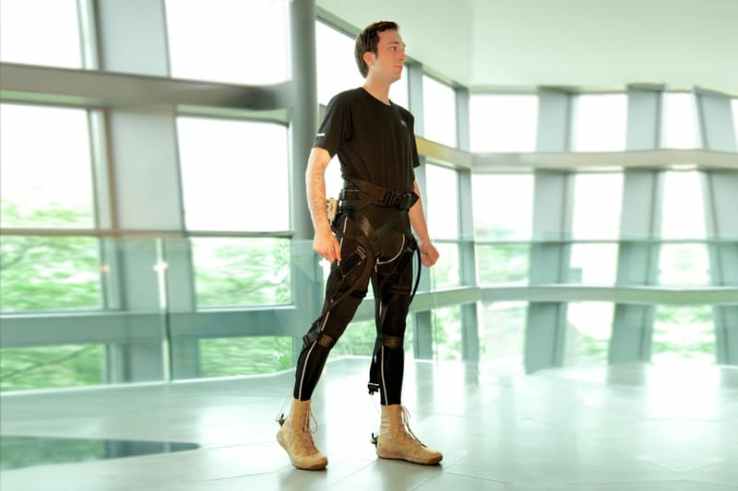Your stroke hospital should have already evaluated this against these other 92 posts on exoskeletons. But I bet nothing was done and you don't have a functioning stroke hospital! A functioning hospital is up-to-date on all things stroke. If you know about it before they do means PURE INCOMPETENCY!
The latest here:
ReStore Exo-Suit Publications Demonstrate Improved Walking Outcomes Versus Conventional Stroke Therapy

Randomized
clinical trial demonstrates significant improvements in walking ability
for patients receiving therapy with the ReStore Exo-Suit as compared to
a matched control group receiving conventional stroke therapy.
Additional study demonstrates that the improvements in walking speed and distance following high-intensity gait training with the ReStore Exo-Suit were maintained by individuals post-stroke 4 weeks after the intervention had concluded.
Combined results highlight the clinical value of the ReStore Exo-Suit and its related breakthrough propulsion-augmenting technologies within the Lifeward product development pipeline.
MARLBOROUGH, Mass. and YOKNEAM ILLIT, Israel, March 08, 2024 (GLOBE NEWSWIRE) -- ReWalk Robotics Ltd. (DBA Lifeward™), (Nasdaq: LFWD) (“Lifeward” or the “Company”), a global market leader delivering life-changing solutions to revolutionize what is possible in rehabilitation, recovery, and the pursuit of life’s passions in the face of physical limitation or disability, today highlighted two recent research publications that demonstrate the effectiveness of the unique propulsion training capabilities of the ReStore Exo-Suit for post-stroke rehabilitation.
“We are encouraged by the tremendous clinical value we see in the ReStore Exo-Suit technology and its ability to retrain and augment propulsion for individuals recovering from stroke,” stated Larry Jasinski, CEO at Lifeward. “We believe these recent studies can broaden the use of robotic therapy in the rehabilitation of patients post-stroke and speak to the potential value of the next generation of products for home use in our development pipeline which are based upon the same ReStore technology. We expect that the experience and infrastructure that we have developed for establishing Medicare coverage of the ReWalk Exoskeleton will also facilitate patients’ access to our future technologies. In parallel, we continue to work actively with CMS to determine a final payment amount for the ReWalk Personal Exoskeleton using the current pricing information we submitted in November 2023.”
The most recent publication, from the University of Pécs in Hungary, titled “Investigation of the Effectiveness of the Robotic ReStore Soft Exoskeleton in the Development of Early Mobilization, Walking, and Coordination of Stroke Patients: A Randomized Clinical Trial” examined key walking metrics for two groups of post-stroke patients, randomized to either a conventional therapy program or a program which included training with the ReStore Exo-Suit. The ReStore intervention group demonstrated significant improvements compared to the control group, including a 56% increase in 10-meter walking speed, and a 68% improvement in 6-minute walking distance, and the improved performance was demonstrated to persist at the post-intervention follow up assessment.
A second study from Boston University was presented in an abstract titled “Durable Improvements in Post-Stroke Walking Speed and Distance Following High-Intensity Training with Soft Robotic Exosuits.” This study demonstrated that a 4-week program of intensive gait training with the ReStore Exo-Suit for individuals post-stroke (N=25) resulted in clinically meaningful increases in walking speed (average: 0.17 m/s) and walking distance (34.4 m) which endured a month after the individual had completed the training program. These improvements in speed and distance were accompanied by significant improvements in propulsion mechanics of the paretic limb.
To learn more about the Lifeward mission and product portfolio, please visit GoLifeward.com.
About Lifeward
Lifeward
designs, develops, and commercializes life-changing solutions that span
the continuum of care in physical rehabilitation and recovery,
delivering proven functional and health benefits in clinical settings as
well as in the home and community. Our mission at Lifeward is to
relentlessly drive innovation to change the lives of individuals with
physical limitations or disabilities. We are committed to delivering
groundbreaking solutions that empower individuals to do what they love.
The Lifeward portfolio features innovative products including the ReWalk
Exoskeleton, the AlterG Anti-Gravity systems, the ReStore Exo-Suit, and
the MyoCycle FES Systems.
Founded in 2001, Lifeward has operations in the United States, Israel, and Germany. For more information on the Lifeward product portfolio, please visit GoLifeward.com.
ReWalk®, ReStore® and Alter G® are registered trademarks of ReWalk Robotics Ltd. (DBA Lifeward) and/or its affiliates.
 The Boston-based company that was first to provide robotic legs to
paralyzed veterans in the U.S., Rewalk Robotics Ltd., has a new product
in development that you won’t see this week at CES. The device is a
“soft exoskeleton,” designed to help people who have lower limb
disability but who have not severed their spinal cord or otherwise
become paraplegic.
The Boston-based company that was first to provide robotic legs to
paralyzed veterans in the U.S., Rewalk Robotics Ltd., has a new product
in development that you won’t see this week at CES. The device is a
“soft exoskeleton,” designed to help people who have lower limb
disability but who have not severed their spinal cord or otherwise
become paraplegic.